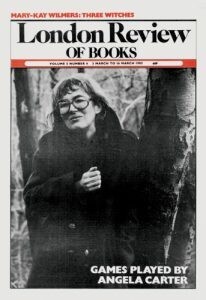Angela Carter in the ‘London Review’
Jenny Turner
‘I like to write about books that give me pleasure,’ Angela Carter wrote in her preface to Expletives Deleted, the collection of her journalism published posthumously in 1992. ‘I also like to argue,’ she said. ‘A day without argument is like an egg without salt.’
Between 1980 and 1991, Carter wrote some of her finest literary tributes for the LRB: Grace Paley, Colette, Christina Stead, Iain Sinclair. But the pieces that really leap at you from the archive are three from the middle 1980s about food and foodies or, as Carter called it, ‘conspicuous gluttony’ and ‘piggery triumphant’, and how ‘genuinely decadent’ she found the foodie search for the perfect melon, ‘as if it were a piece of the True Cross’.
Carter’s review of The Official Foodie Handbook was published in January 1985, ‘at just the time when Ethiopia is struck by a widely publicised famine’, as she noted in the piece. The letter writers went into spasm. ‘I see small reason to entrust the review of three cookery books to … a woman who obviously has a Puritanical contempt for decently prepared food,’ wrote one. And it’s true that Carter’s relations with food were complicated – she was a recovering anorexic. But she liked cooking and loved a good cook book, as she showed in her 1987 piece on Patience Gray and the other ‘awesomely sophisticated, aristocratically beautiful’ authors of the classic mid-century cook books – the celebrity chefs of the age just before television took over.
‘She sneers at those of us who buy expensive foodstuffs while Ethiopians starve,’ another reader complained. ‘Does she think notbuying these things will bring about beneficial changes in that country’s political turmoil?’
But Carter’s interest is in the way fashions in food connect to deep concerns about sex, status, death, religion: the potato, for example, appreciated as ‘a godless vegetable’ in her 1986 review of The History and Social Influence of the Potato by Redcliffe Salaman; or the ‘post-hippy Platonism to do with the real and the phoney’ behind the Chez Panisse cult and Alice Waters’s ‘wincingly exquisite cuisine’.
Most of Carter’s big fashion pieces were written before her LRB days, during her long residency at New Society magazine. But in 1985 she reviewed Elizabeth Wilson’s Adorned in Dreams – the best book Carter had read on the subject, she said, ‘bar none’. With the small caveat that Wilson ‘tends to misread’ icons of the 1960s, including Twiggy, ‘the whole point’ of whom, Carter thought, ‘was the contradiction between the extraordinary refinement of her features and the raucous cheerfulness of her personality. She looked, and, indeed, still does, like a creature from another planet where people are more beautiful than we are: and she sounded, as her then boyfriend remarked, like ‘a demented parrot.’ (It was only ‘mums and dads’ who really thought she was lovely,’ Carter considers. ‘Marianne Faithfull, now …’)
Of other writers’ reviews of Carter in the LRB, Tom Paulin’s take on Nothing Sacred (1983), a collection of her early journalism, is particularly worth a look. ‘The laureate of deindustrialised England,’ he calls her: ‘the most advanced stylist in the country’; ‘an ironic, ludic, cultivated imagination, which is free from class guilt, bored by the old-fashioned idea of Great Britain, peace-loving and generously multi-racial.’
And it’s interesting to see that Paulin, more than thirty years ago, was already floating an idea now coming up in discussions of Carter’s work more and more: that the journalism and essays may be lasting better than the fiction. ‘Her fictions suffer,’ Paulin wrote, ‘from the absence of what Keats termed “disagreeables”’: Carter was so good at inventing things, it all becomes a bit too easy, ‘an expansive territory without boundaries or horizons, a kind of permanent and infinite vanishing’.
When I read my favourites among Carter’s essays, I find myself agreeing with Paulin; until I read certain stories and bits of novels, and then I don’t. On screens and goddesses, for example, the pieces Carter wrote about Louise Brooks and Bertolucci’s La Luna certainly do form pieces of the crazy jigsaw. But the picture really comes together in ‘The Merchant of Shadows’, a story the LRB published in 1989 which was collected in the posthumous American Ghosts and Old World Wonders (1993).
‘I used to think of prayer wheels,’ the ancient movie star says to her adoring young acolyte:
Night after night, prayer wheels ceaselessly turning in the darkened cathedrals, those domed and gilded palaces of the Faith, the Majesties, the Rialtos, the Alhambras… While the wonderful people out there in the dark, the congregation of the faithful, the company of the blessed, they leant forward, they aspired upwards, they imbibed the transmission of divine light.
Now, the priest is he who prints the anagrams of desire upon the stock, but whom does he project upon the universe? Another? Or, himself?

Comments